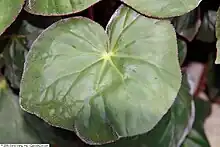Begonia acetosa
Begonia acetosa is a species of flowering plant in the family Begoniaceae, native to southeastern Brazil.[2] It is used to create new begonia hybrids due to its attractive foliage.[3][4] Begonia acetosa has been cultivated in the United States since 1946, when Mulford B. Foster introduced the species from forested mountains near Rio de Janeiro.[5] It was first described in 1831 by José Mariano de Conceição Vellozo. The specific epithet acetosa means 'acid' or 'sour', referring to the rhubarb-like taste of its leaves.[5]
| Begonia acetosa | |
|---|---|
 | |
| At the Victoriaväxthuset botanical garden, Sweden | |
 | |
| Close-up of leaf | |
| Scientific classification | |
| Kingdom: | Plantae |
| Clade: | Tracheophytes |
| Clade: | Angiosperms |
| Clade: | Eudicots |
| Clade: | Rosids |
| Order: | Cucurbitales |
| Family: | Begoniaceae |
| Genus: | Begonia |
| Species: | B. acetosa |
| Binomial name | |
| Begonia acetosa | |
| Synonyms[1] | |
|
Begonia cantareira hort. | |
Begonia acetosa is an herbaceous, creeping, rhizomatous begonia, growing up to 1 m (3 ft) tall. It has thick, horizontally spreading, pale green branches. Leaves are ovate to orbicular, and asymmetrical.[6][5] The leaves are a dull green on the upper surface and a deep wine red on the under surface. Both the underside and upper surface of the leaf are covered with a dense layer of short white hairs. Petioles are a rusty reddish brown to a deep red, and covered in short, woolly hairs. The flowers of B. acetosa are white.[6]
References
- "Begonia acetosa". The Royal Horticultural Society. 2023. Retrieved 18 June 2023.
- "Begonia acetosa Vell". Plants of the World Online. Royal Botanic Gardens, Kew. Retrieved 18 June 2023.
- Siregar, Hartutiningsih M.; Ardaka, I Made; Siregar, Mustaid (2009). "Begonia 'Tuti Siregar' (Begonia listada Smith & Wasshausen × Begonia acetosa Vellozo): A new cultivar from Bali Botanic Garden, Indonesia". Biodiversitas Journal of Biological Diversity. 11. doi:10.13057/biodiv/d110104.
- Permata, Dara AYU; Susandarini, Ratna (2022). "Morphological diversity and phenetic relationship of wild and cultivated Begonia based on morphology and leaf venation". Biodiversitas Journal of Biological Diversity. 23 (2). doi:10.13057/biodiv/d230235. S2CID 247443045.
- Tebbitt, Mark (2005). Begonias. Timber Press. p. 75.
- "Begonia acetosa Vell". nparks.gov.sg. Flora Fauna Web. 14 July 2023.